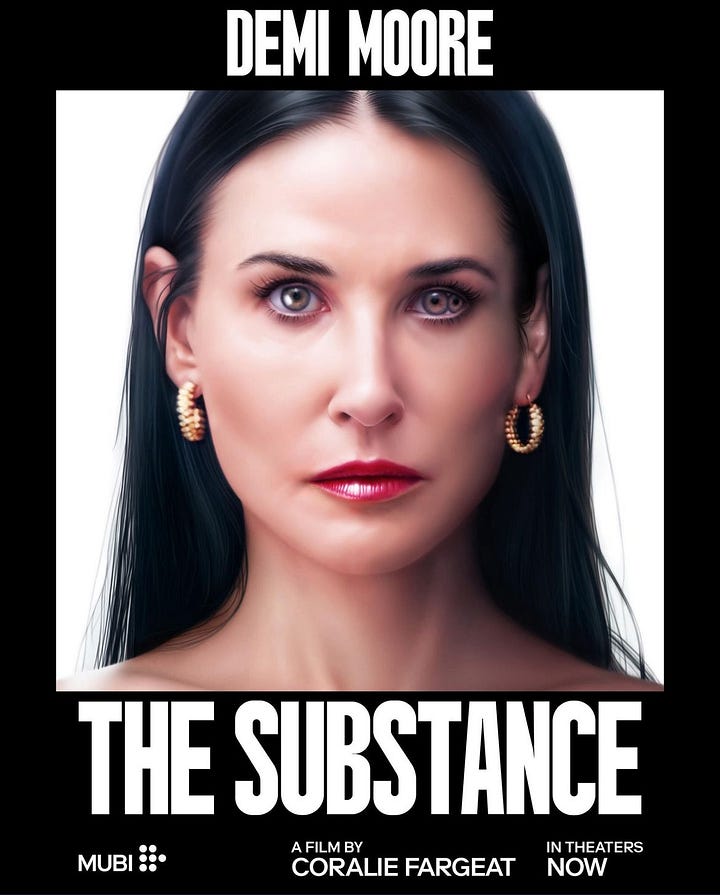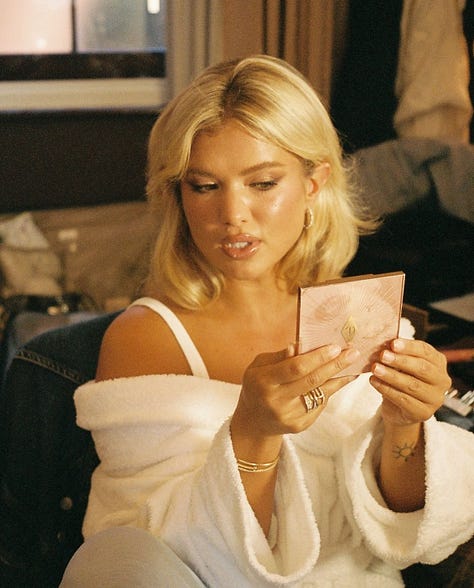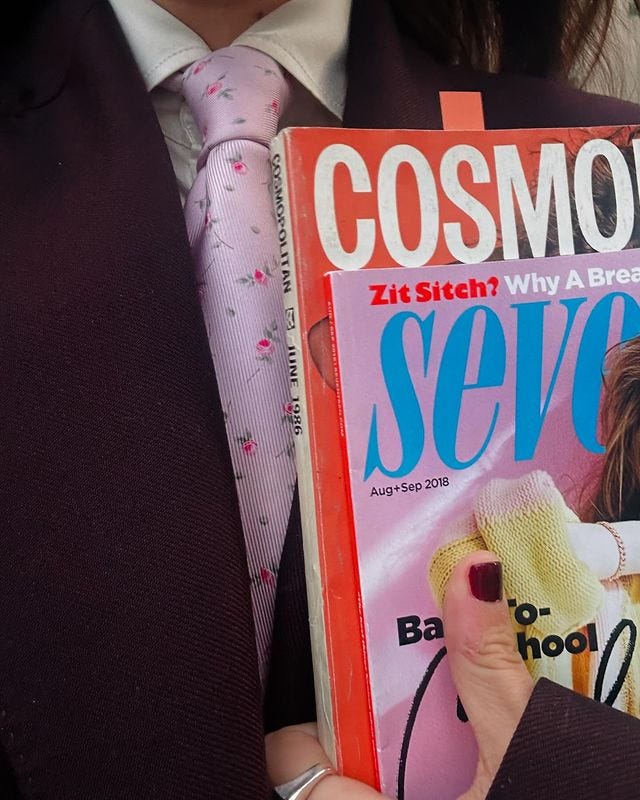QUICK HITS
TikTok to shut down its music streaming business in November
California sues ExxonMobil over alleged role in plastic pollution crisis
Google CEO Sundar Pichai announces $120M fund for global AI education
This video of Chrissy Teigen doing the viral cucumber recipe came up on my feed yesterday. It made me feel sad for her. This is a common reaction when faced with a celebrity trying to get in on a TikTok trend. Something about the overproduction of it all, the self-awareness, the inauthenticity... it takes the fun out of the whole thing. It’s like when the CEO sits with the interns at lunch because they want to be fun and approachable—everyone’s uncomfortable, the jokes are stilted, and the smiles are fake. It’s a literal production when it should just be lunch. As I always say, media training is the antithesis of TikTok.
So, Brooklyn Beckham launched a condiments and sauces company. I’m not mad. Their first SKUs are Jalapeño and Habanero hot sauces, and you can get them exclusively at Whole Foods or online. Thankfully, Brooklyn isn’t going at it alone. His co-founders, Gabe Pepe and Kai Goyoso, both work at Range Media and helped launch Brooklyn’s Instagram Reels cooking videos. CEO Forbes Fisher has a long résumé in CPG. The packaging is beautifully designed, and speaking to
, the team said, “The textured glass bottles are inspired by the spirits industry, where bottles are meant to be displayed outside. Similarly, they designed these bottles not to be confined to your fridge or pantry.” I’ve written a lot about food as a status symbol. I find it fascinating that with each new CPG product launch I see, more emphasis is put on the packaging and overall branding, and less on the product itself. You could read an entire article about a new launch without any indication of how the thing tastes.

A new Whole Foods market survey found that 70% of Gen Z supports climate-smart agricultural practices, 55% are willing to pay more for environmentally sustainable products, and over half of Gen Z consumers prefer brands that prioritize lower environmental impacts or locally sourced foods. Lovely. What the survey didn’t capture is that all of these preferences are very subject to financial constraints. Might be a hot take, but I think the idea that Gen Z will pay a premium for sustainable products is a bit overplayed. Theoretically, we would, but the data doesn’t always back that up. Have you spent any time on TikTok?! The survey also found that 70% are willing to spend more on high-quality food, and this I can get behind. Will Gen Z pay a premium for sustainability? Maybe. Will Gen Z pay a premium for food (or anything) they think will make them hotter, smarter, stronger? Yes.
Take Saie, for example. The makeup brand just launched the Saie Climate Initiative, a new three-year partnership with rePurpose to recover 5 million pounds of global plastic waste by 2027 while reaching carbon net-zero by 2039. I think it’s great. As a Gen Z consumer who cares about the environment, this increases my positive association with the brand, and overall brand perception. So, if I'm at Sephora and have to pick between two lip glosses of similar quality and price points, I’ll probably go for Saie—assuming I remember what they stand for at that moment. But if I already didn’t like the product or it was above my price range, their values probably wouldn’t change my purchase behavior.
It was 2021, and there was that one viral post about this group of friends that bought a house together. They would die old and happy, without babies and men. A lot of people must have bought into the vision because the number of co-buyers with different last names hit a record in 2021. If you want to know how that’s going, that number fell 29.5% over the following two years, and the number of co-owners planning for potential exits rose significantly between 2021 and 2023, according to CoBuy, an app for shared homeownership. Some of those friendships will never recover.
Sorry, but the media speculation about Justin Bieber’s relationship with Diddy is actually appalling. Hope the clicks are worth it.
Democrats are scared of Republicans, so now they’re buying guns too. In the 90s, the number of Democrat gun owners dropped significantly as political divides around firearm laws grew more pronounced. Democrats wanted gun regulation, and Republicans wanted their guns. Now, gun ownership is on the rise among Democrats. Kamala Harris and Tim Walz are apparently both proud gun owners, and 29% of Democrats or those leaning Democrat reported having a gun at home in 2022, up from a four-decade low of 22% in 2010. Reading this WSJ article, it sounds like protection is the biggest motivation—specifically, protection from neo-Nazis and the likes. The comments section was turned off for a few days, but now it’s open, and I’ve never seen conservatives more excited about a WSJ article. My top picks:
“Hypocrisy of the left has no bounds…!”
“Nothing new here. Just go to any gun range across the country, it's full of liberals, LGBT, white, blacks, latinos, Asians, women, men, etc.”
“So libs must buy a gun to protect themselves from law-abiding Conservatives? Such convoluted thinking could only come from an echo chambered lib cocooned in a coastal city.”
I got a lot of responses to what I wrote last week about the lack of innovation in the geriatric space, so now I’m going to stay on that beat. Another really good article on the subject came out recently, this time about China’s thriving “Silver Economy.” In 2022, China’s population shrank for the first time since 1961, and last year the number of people aged 60 and over topped 290 million, or one in every five Chinese people. Businesses are adjusting accordingly. “Dairy companies that produced formula for China’s infants are now developing powdered milks for seniors. Proprietors of preschools and kindergartens are closing those facilities to start senior care centers. A technology firm that made devices for parents to track their young children is now designing products allowing grown children to keep tabs on their aging mothers and fathers.”


We’re not quite there yet, but one interesting nuance I already see is that while the Chinese market is responding to an aging population by making society and technology more elderly-friendly, the West is investing heavily in LONGEVITY instead. If that’s not telling, I don’t know what is. A large cohort of startups aimed at slowing or sustaining biological age have raised billions of dollars over the last few years. I’ve written about some of them. BioAge Labs, a company that develops therapeutics for obesity and other metabolic diseases by targeting the biology of human aging, is seeking to raise $142.5 million on Nasdaq, making it one of the splashiest longevity IPOs to date. Today, the Times published a story about how more anti-aging enthusiasts are using the immunosuppressive drug Rapamycin to slow the aging process. One of the most talked about movies this month is Mubi’s The Substance, about an aerobics celebrity who gets fired by her boss when she turns 50 and a laboratory that offers her a substance promising to transform her into an enhanced version of herself. The food we eat, the makeup and skincare we use, and the exercise we do are all increasingly marketed to us with a dose of LONGEVITY. America values youth above all else, so no one wants to get old. But everyone is getting old, and I’m interested in seeing how much of our resources will go towards supporting that population versus preventing people from getting there.
News outlets are experimenting with creating WhatsApp Channels that allow them to send links and headlines directly to followers. African parents would love this (iykyk). Noticias Telemundo, the news arm of Telemundo, said the channel is already driving more traffic than X. Other media outlets have signed up for WhatsApp Channels, including CNN (14.5 million followers), the Times (14 million), The WSJ (4.7 million), and WaPo (3.8 million). We’ve known for a while now that brands want in on the group chat. Personally, I hate the idea of getting direct messages from brands or publications—I get mad when even Vodafone sends me texts— but private messaging is a huge trend right now, so maybe I’m in the minority here. So if brands must use this channel, I’d love to see how they play with language and format. Don’t be lazy in my dms.
Okay, this is hot. Is Willa telling us we’re getting print back?
VICE— which went bankrupt but is maybe better now, and was going to launch on beehiv but clearly decided not to—is bringing back VICE Magazine. For their 30th anniversary next month, they will revive The Photo Issue, followed by four print issues next year featuring long-form reporting from across the world, new (and returning) star columnists, music reviews, confessions, guides, and GIF round-ups. To fund this, they’re starting a subscription business, which will give members access to “a bunch of online exclusives” in addition to the magazines. I don’t know about those exclusives, but I’m bullish on VICE returning to print. If they can keep overhead costs low, this could be a more sustainable business for them than digital. They can scale back on content, focus on rebuilding their brand, and invest in high-quality content and design.
Sherwood did a great analysis of how Hollywood as an industry is shrinking, as the firehose of investment from streaming companies has reduced to a trickle in the last year. Take a look at recent earnings reports, and you’ll find every major streamer—Disney, Apple, Paramount, NBCUniversal, Amazon, and others—emphasizing quality over quantity in their content strategies. They’re investing in fewer original and scripted programs and pivoting to other entertainment options like live sports. More media megamergers also decreases the overall number of buyers for films and TV, adding more weight to any one buyer’s decision to cut spending or shift content strategies. Both factors lead to less work employment opportunities, or worse, layoffs. We’re getting a front-row seat to that show as Paramount starts phase two of its post-acquisition layoffs. And we haven’t even touched on AI yet. But as streamers attempt to rebuild cable’s business model, they could also start experimenting with more cable-style TV formats like procedurals, sitcoms, and game shows. Licensed shows like Suits, Grey's Anatomy, and Young Sheldon are among Netflix’s most-watched programs. Netflix recently ordered the medical procedural “Pulse,” with one scripted exec saying they’d be surprised if it got only eight episodes.
The co-founder of Starface and Julie launched Overdrive, a new drug safety and harm reduction brand with Fentanyl test kits as its first products. Ryan Weaver, the brand’s executive producer and creative lead told Vogue, “Our brand is intentionally trying to feel more like an energy-drink brand and less like a sterile medical brand.” I see it. If you came across their Instagram page without knowing what they are, you’d probably think Overdrive was some kind of youth lifestyle brand. There’s a lot of skate and motorsport content, and TikTok style skits. The product itself only showed up in a post yesterday. Speaking to People Brands and Things, the team said they plan to host and sponsor events to raise awareness for the brand.


I love Margot Robbie and Jacob Elordi as much as the next girl, but those two do not belong on the moors! Excited to see what Emerald Fennell does with Wuthering Heights, apart from getting me to believe dear Margot Robbie is a teenager and Jacob Elordi is her 40 year old lover.
Peloton isn’t going down without a fight. In August, the exercise equipment company that wants to be more than an exercise equipment company reported its first rise in sales in more than two years. CMO Lauren Weinberg told The WSJ that the company is working on a marketing campaign to reposition Peloton as a suite of services for a range of customers with varying fitness goals—not just an indoor biking company. They will also be targeting millennial men, who apparently view Peloton as a women’s brand. The most interesting thing I learned was that the company is building a weightlifting app, which proves they know what we all know— when it comes to indoor solo exercise, strength training is where the money’s at.
For reasons beyond me, Elon Musk has decided that X will let people you’ve blocked see your public tweets. I searched high and low for the logic behind this and came up with nothing.
Polymarket is in talks to raise $50 million in new funding. The blockchain-based prediction market has surged in popularity this election season, with people betting on election outcomes and popularly, Taylor Swift’s engagement prospects. Polymarket currently has around 100,000 traders on the platform, many of whom joined this year, and has done about $1.45 billion in trading volume as of mid-September. They also have a Substack with almost 30k subscribers. Not to be overly moralistic, but I think shit like this is net negative for society.
Over the top PR packages usually make me cringe, but these Glossier fragrance ones have me… curious. My friend Kennedy did as much of an unboxing as she could on her TikTok, and I’ll be honest, this is pretty sick.
And Poppi is the Glossier of CPG. Obviously.
I took over Jessica DeFino’s newsletter for this week’s Don’t Buy List roundup. I wrote about hair growth start-ups, telemedicine, testosterone replacement therapy, and crucially, releasing trauma for weight loss:
Kids these days are losing weight simply by releasing their trauma. According to TikTok, at least. I spent the first sixteen years of my life in Nigeria, but I’d never met a self identified traumatized person until I moved to America. At my liberal arts college in Portland, everyone was traumatized, and I needed to tread carefully lest I trigger that trauma. I too was probably carrying a lot of trauma, I just didn’t realise it- due to the trauma, obviously. The key to a happy, fulfilled life was finding ways to release said trauma. No one I met had yet managed that, but it was a utopia to which we could collectively aspire. It was a weird four years. I would have been a lot more dedicated to my “inner work” if I had known that was the key to dropping my freshman fifteen. Because according to a slew of apps and influencers, “somatic exercise” or “trauma releasing” will help heal my mind and body from traumatic events and improve my sleep and WEIGHT LOSS. Wild.
Pheromone perfumes for men and women are outperforming other fragrances on Amazon. For the run clubs and book clubs and all the clubs!
I wonder how Matilda Djerf’s hair care line is doing. They just came out with two new hair care collections, each featuring three products. Two years in the making, if you were wondering.



Wow, Youthforia actually hired a Director of Product Development. Oh, to be a fly on the wall in those interviews. I actually think it’s smart of them to make this hire after all the backlash about their jet black foundation died down. Oby Jemedafe was formerly a Marketing and PD consultant for Cecred and the Director of Marketing, and PD at Uoma Beauty before that. I think it’s ridiculous that this role also has DEI folded into it, but whatever.
Speaking of, people don’t know racism is a sin, and that’s an issue. Seeing how this unfolded makes me scared of you guys.
“A relatively brief, entirely incomplete history of online fashion fandom” is this amazing timeline Emilia Petrarca put together for SSENSE. It covers everything from the launch of Style.com to the rise of bloggers, social media, Rookie Mag, Into The Gloss, all the way to the current Substack Boom.
Happy (belated) Sally Rooney release date to all who celebrate. Unlike some of you, my powers of self-control are beyond reason, and so I will be waiting till I’m in the U.S. this December to buy the book. UK covers are always so dreadful. I haven’t been able to keep up with all the Rooney interviews and profiles that have come out in the last week, but this Vogue one about why her characters are always so thin caught my eye. I actually didn’t read it because I don’t care to know, but then my friend
posted this on her bookstagram and I thought, lol, yes.
In case you hadn’t heard, Gen Z is LUSTY for MONOGAMY.
A study from Feeld and Dr. Justin Lehmiller of the Kinsey Institute found that while Millennials and Gen X showed a preference for ethical non-monogamy, and Boomers for friends with benefits, Gen Z—the most kink-friendly generation—fantasizes about monogamy. Additionally, we are the generation least likely to want open relationships. I’ve seen a few people—none of them Gen Z— express surprise at these findings. To me, it made perfect sense, but I decided to ask some of my Gen Z friends what they thought was happening here.
I think the high visibility of polyamory skews our perception of modern relationships. I’d wager that Gen Z overestimates the number of people in poly or open relationships, making us desire monogamy more because we think it’s rarer than it is. Also, we are considered the loneliest generation or whatever. People aren’t dating, they aren’t going out, and they’re not having flings (situationships are not flings), which makes us desire monogamous relationships more. You want what you can’t have. —Maddi, 25
I used to scoff at the idea of marriage and monogamy. I bought into the “pick me” mentality that relationships don’t matter and that monogamy and marriage are embarrassing. But looking back, I realize I never actually believed that. My views were shaped almost entirely by what I thought men wanted. With exposure to more "open" forms of dating and sex, maybe Gen Z women are reverting to traditional dating out of sheer exhaustion? As we try to move away from the “cool girl” persona, it becomes clearer that those more open forms of dating don’t serve us as well as we thought they would. —Olivia, 26
Our parents have the highest divorce rate, so seeing something not work makes people want to try to make it work and understand what they don’t want in a monogamous relationship. It’s also essentially possession; I guess that’s what comes naturally. —Matthew, 27
Let’s set the scene: we’ve grown up with social media and have been conditioned to believe that more clicks, likes, followers, and matches are better. But we know that isn’t the case, so many young people are trying to reclaim their relationship with technology and how it shapes our lives. Particularly, how it shapes our relationships. What we’re all after is love, connection, and companionship. Yet, despite being more connected than ever, we’ve become separated by screens. In a world that claims connecting with more people will make you feel better (spoiler: it doesn’t), the obvious inverse is the idea that there is one person out there who can be your go-to in life. We’re trying to shift from a world that prioritizes infinite connections to one that centers on intimate connections. — Anushka, 25
Because everything for Gen Z is so unstable and uncertain, and the idea of monogamy = security?? At least I did some inner reflecting, and that’s what it is for me. We’ve seen so much instability in our lifetimes (international and domestic conflict, the pandemic, one big recession and now maybe another), and I think it is easy to latch onto the idea that monogamy will be the opposite of all of that. Then there’s the pandemic. My social circle got a lot smaller, and the way I meet and interact with people has changed. I now find myself preferring more intimate hangouts, rather than, for example, a large group outing at a bar. I wonder if that translates to gravitating toward monogamy. — Emily, 26
Monogamy is the new forbidden fruit. Unlike our parents, where being open was the forbidden fruit. It’s actually super uncool as a woman to love your boyfriend a lot. So basically, we want what is no longer the norm. — Ridah, 25
I think the key word here is “fantasize.” What’s often missing for most Gen Z’ers in the landscape of dating apps, rosters, and FWB is that intimate connection that you get within a relationship. I’ve never been in a polygamous relationship, so I can’t comment, but my thinking would be that the “fantasizing” in this case would be less about the sexual aspects that can be found in monogamous or non-monogamous relationships and more about the intimacy, connection, and desire for growth that comes from a committed relationship. — Raphael, 27
XO








new subscriber here -- just wanna say, LOVE your newsletter. THIS is what I want my group chats to read like: M&A squabbles in luxury fashion; niche brands and their even niche-r PR and marketing strategies; pop culture news; what everything means, analyzed from a sociological lens. bravo!
Hi - Love your newsletter!
I don't know where I read this, so need to double check if it is factual, but what I read was that, the reason X is removing the block function is because Elon Musk had a tweet about some big events (may be superbowl ), and at the same time president Biden also had a similar tweet. Despite of having far more followers, Elon Musk's tweet was getting way less exposure and engagement than President Biden's. And he was not happy about that, even left the event early and called in engineers at Sunday night to see why his tweet was "under performing". And the engineers had to change the algorithm for his tweet to appear at people's feed regardless if they follow him or not...and that leads to showing content to people who you have previous blocked.
Again I don't remember exactly where I read this but I do remember being shocked and disgusted by this. And someone made a comment on this saying "no wonder he and Trump get along".